Analyzing the Characteristics of Soil Moisture Using GLDAS Data: A Case Study in Eastern China
Abstract
:1. Introduction
2. Materials and Methods
3. Results and Discussion
3.1. Characteristics of Climate Change in East China
3.1.1. The Changes of Temperature and Precipitation
3.1.2. The Seasonal Changes of Soil Moisture
3.1.3. The Long-term Changes in Soil Moisture
3.2. The Relationship between Precipitation, Temperature and Soil Moisture
3.3. The Quantitative Relationship of Precipitation and Temperature to Soil Moisture
3.4. Discussion
4. Conclusions
Acknowledgments
Author Contributions
Conflicts of Interest
References
- Zhang, Q.; Wang, S.; Wei, G. A study on parameterization of local land-surface physical processes on the GOBI of northwest China. Chin. J. Geophys. 2003, 46, 616–623. [Google Scholar] [CrossRef]
- Guan, X.D.; Huang, J.P.; Guo, N. Variability of soil moisture and its relationship with surface albedo and soil thermal parameters over the Loess Plateau. Adv. Atmos. Sci. 2009, 26, 692–700. [Google Scholar] [CrossRef]
- Zhu, Q.; Lan, H.; Shen, T. Numerical study of the influence of soil moisture and surface albedo on climate of north part of China. Acta Meteoro-Log. Sin. 1996, 54, 493–500. [Google Scholar]
- Ma, Z.; Wei, H.; Fu, C. Progress in the research on the relationship between soil moisture and climate change. Adv. Earth Sci. 1999, 14, 300–303. [Google Scholar]
- Li, B.; Wen, X.; Wang, L.; Yan, P. Tendency of soil moisture in spring of Heilongjiang province in recent 30 years. J. Arid Meteorol. 2011, 29, 289–296. [Google Scholar]
- Wang, L.; Wen, J.; Wei, Z.; Hu, Z. Soil moisture over the west of northwest China and its response to climate. Plateau Meteorol. 2008, 27, 1257–1266. [Google Scholar]
- Chen, S.; Guo, Y.; Zheng, Y.; Wang, J. Impact of precipitation on soil moisture in Gansu arid agricultural regions. J. Desert Res. 2012, 32, 155–162. [Google Scholar]
- Zhang, Q.; Xiao, F.; Niu, H.; Dong, W. Analysis of vegetation index sensitivity to soil moisture in northern China. Chin. J. Ecol. 2005, 24, 715–718. [Google Scholar]
- Guo, N.; Chen, T.; Lei, J.; Yang, L. Estimating farmland soil moisture in eastern Gansu province using NOAA satellite data. J. Appl. Meteorol. 1997, 8, 212–218. [Google Scholar]
- Liu, S.; Lin, H.; Hu, F.; Liang, F.; Wang, J.; Liu, H. Numerical simulation of evapotranspiration mechanism over soil-vegetation-atmosphere system. Arid Meteorol. 2004, 22, 1–10. [Google Scholar]
- Tapley, B.; Bettadpur, S.; Ries, J. GRACE Measurements of Mass Variability in the Earth System. Science 2004, 305, 503–505. [Google Scholar] [CrossRef] [PubMed]
- Long, D.; Scanlon, B.; Longuevergne, L.; Sun, A.; Fernando, D.; Save, H. GRACE satellite monitoring of large depletion in water storage in response to the 2011 drought in Texas. Geophys. Res. Lett. 2013, 40, 3395–3401. [Google Scholar] [CrossRef]
- Long, D.; Shen, Y.; Sun, A.; Hong, Y.; Longuevergne, L.; Yang, Y.; Chen, L. Drought and flood monitoring for a large karst plateau in Southwest China using extended GRACE data. Remote Sens. Environ. 2014, 155, 145–160. [Google Scholar] [CrossRef]
- Reichle, R.; Koster, R.; Liu, P.; Mahanama, S.; Njoku, E.; Owe, M. Comparison and assimilation of global soil moisture retrievals from the Advanced Microwave Scanning Radiometer (AMSR) for the Earth Observing System (AMSR-E) and the Scanning Multichannel Microwave Radiometer (SMMR). J. Geophys. Res. Atmos. 2007. [Google Scholar] [CrossRef]
- Niu, G.; Yang, Z.; Dickinson, R. Development of a simple groundwater model for use in climate models and evaluation with Gravity Recovery and Climate Experiment data. J. Geophys. Res. Atmos. 2007, 112, 277–287. [Google Scholar] [CrossRef]
- Quintana, P.; Moigne, P.; Durand, Y. Analysis of near-surface atmospheric variables: Validation of the SAFRAN analysis over France. J. Appl. Meteorol. Climatol. 2008, 47, 92–107. [Google Scholar] [CrossRef]
- Koster, D.; Dirmeyer, P.; Guo, Z. Regions of strong coupling between soil moisture and precipitation. Science 2004, 305, 1138–1140. [Google Scholar] [CrossRef] [PubMed]
- Hu, M.; Ding, H.; Liao, F. An improvement on summer regional climate simulation over East China: Importance of data assimilation of soil moisture. Chin. Sci. Bull. 2009, 54, 2388–2394. [Google Scholar] [CrossRef]
- Zhang, X.; Wu, X.; He, J. Vertical character of soil moisture in China. Acta Geogr. Sin. 2004, 62, 60. [Google Scholar]
- Ma, Z.; Wei, H.; Fu, C. Relationship between regional soil moisture variation and climatic variability over east China. Acta Geogr. Sin. 2000, 58, 284–286. [Google Scholar]
- Houser, R.; Michael, B.; Brian, C. NASA/NOAA’s Global Land Data Assimilation System (GLDAS): Recent Results and Future Plans; Hydrological Sciences Branch NASA Goddard Space Flight Center: Greenbelt, MD, USA, 2000.
- Rodell, M.; Houserp, R.; Jambor, U. The global land data assimilation system. Am. Meteorol. Soc. Bull. 2004, 85, 381–394. [Google Scholar] [CrossRef]
- Pearson, K. Notes on regression and inheritance in the case of two parents. Proc. R. Soc. A Math. 1895, 58, 240–242. [Google Scholar] [CrossRef]
- Mann, B. Non-parametric tests against trend. Econometrica 1945, 13, 163–171. [Google Scholar] [CrossRef]
- Kendall, G. Rank Correlation Methods, 4th ed.; Charles Griffin: London, UK, 1975; p. 202. [Google Scholar]
- Huang, P.; Guan, D.; Ji, F. Enhanced Cold-Season Warming in Semi-Arid Regions. Atmos. Chem. Phys. 2012, 12, 5391–5398. [Google Scholar] [CrossRef]
- Sun, C.; Gao, F.; Qu, J. Latest knowledge on global climate change. Chin. J. Nat. 2002, 24, 114–122. [Google Scholar]


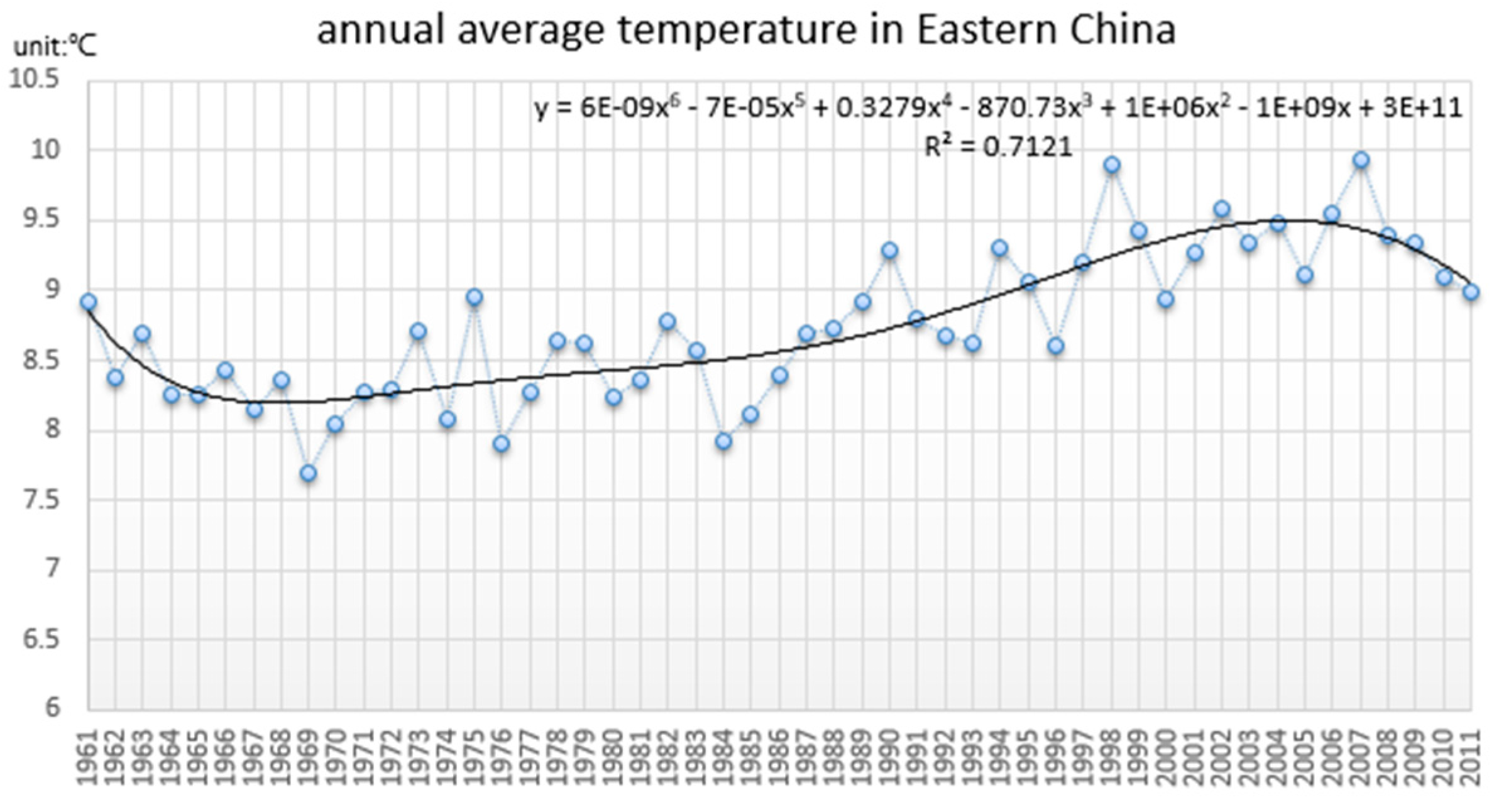
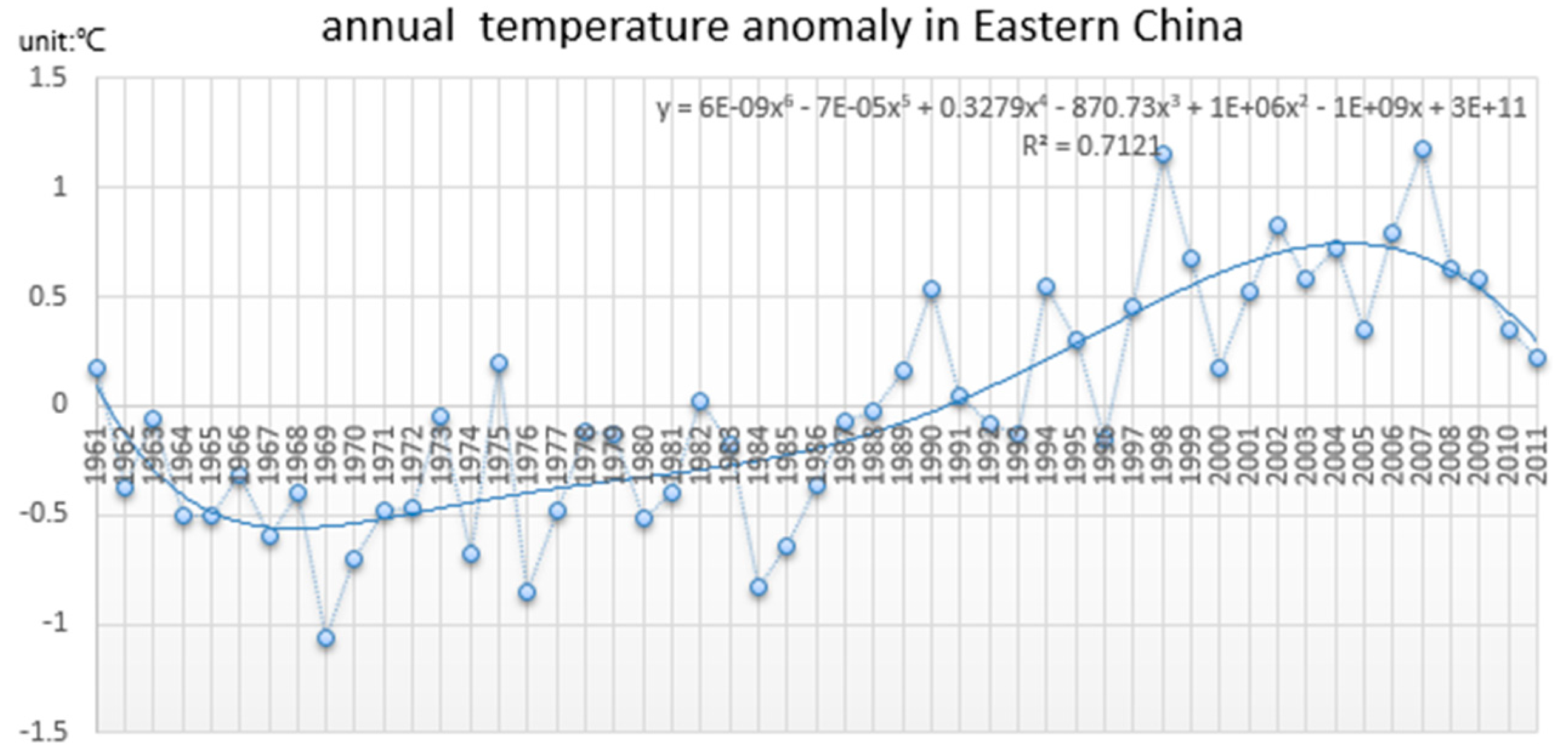
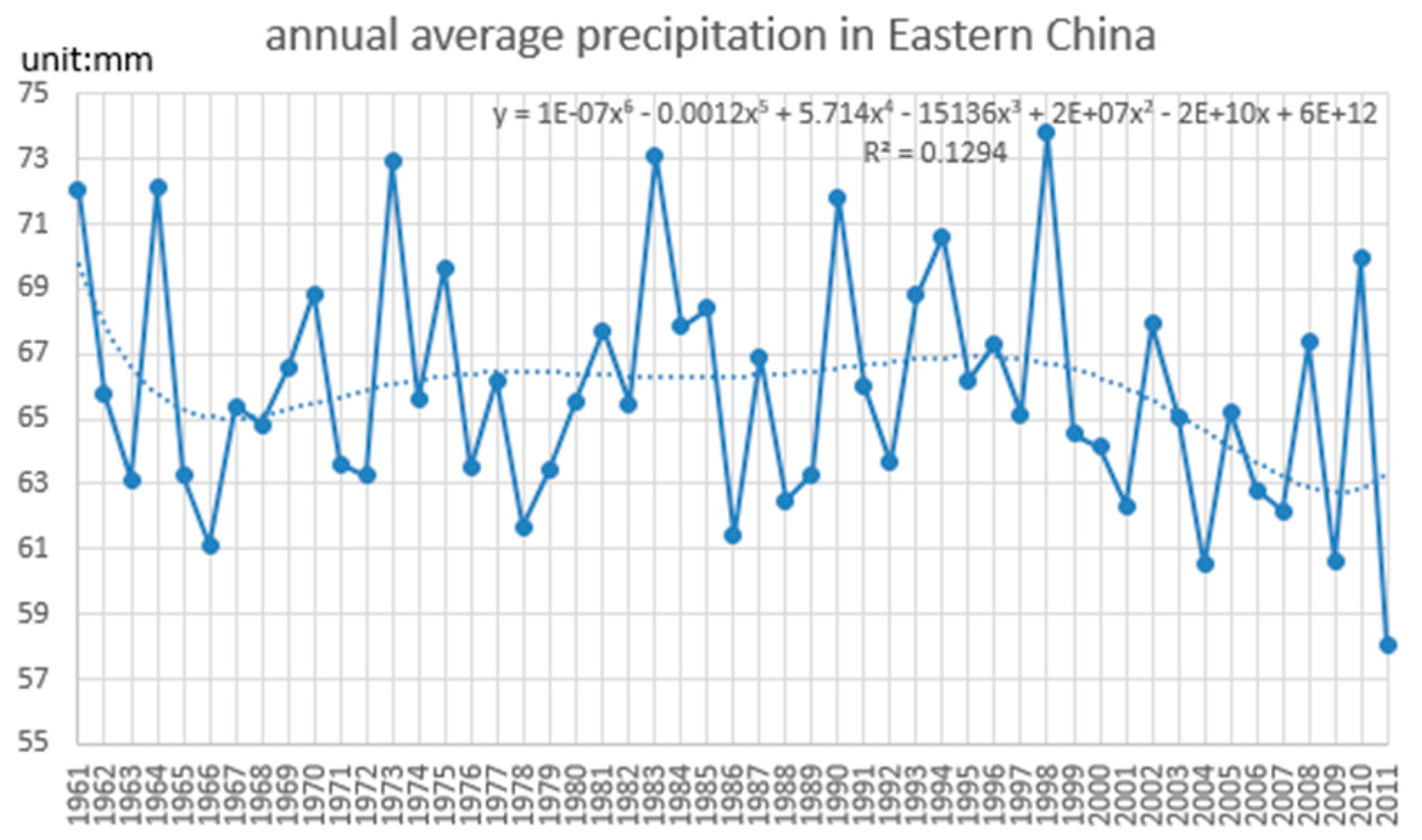
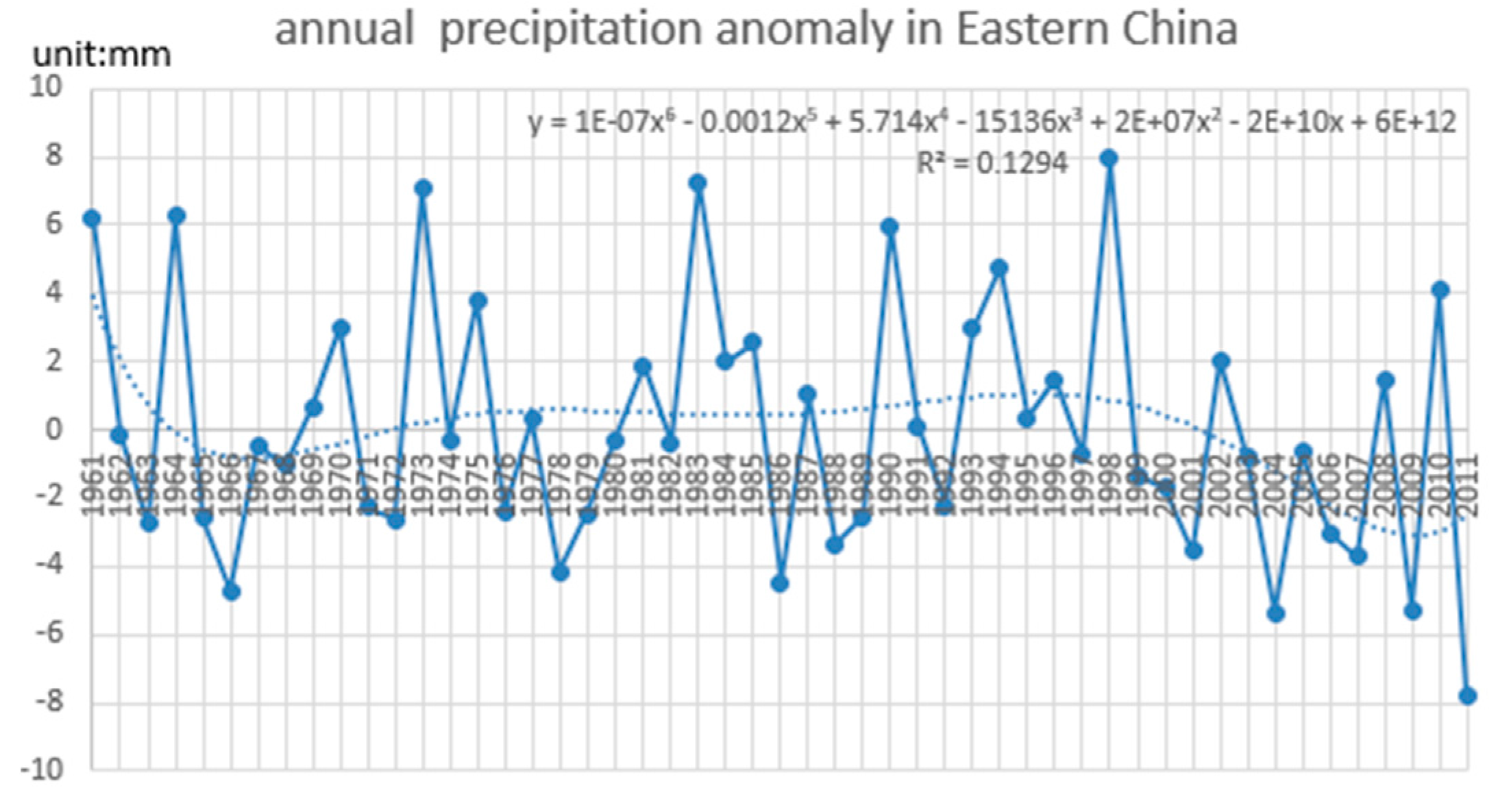

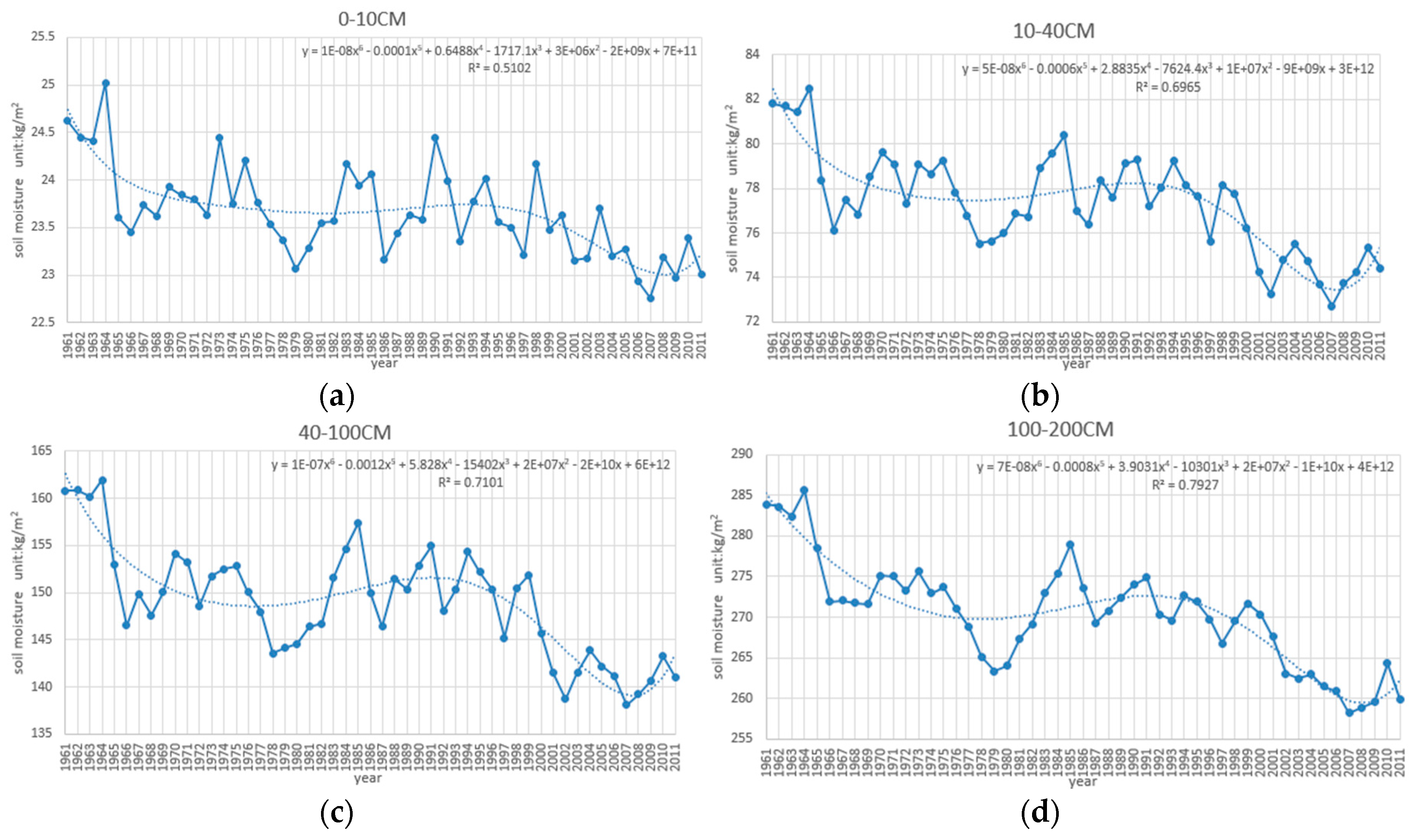
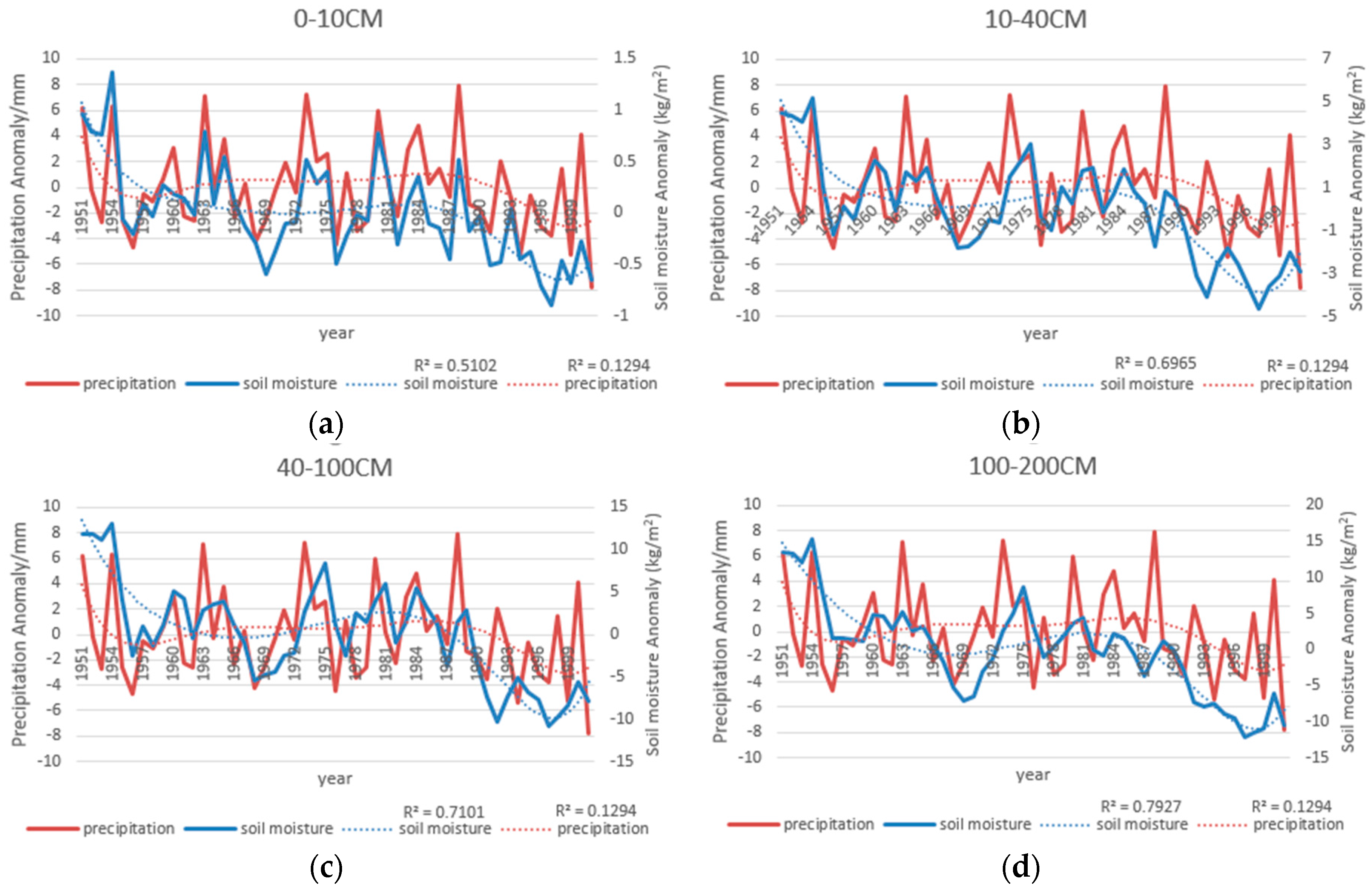

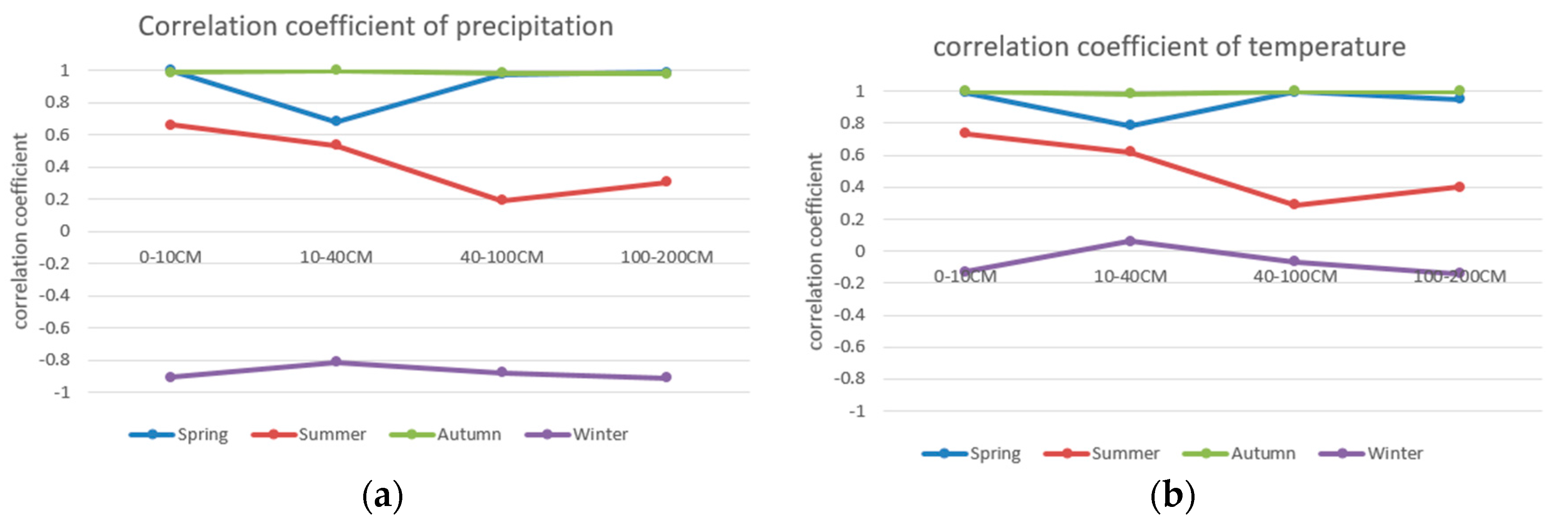
| Category | Value Zc | Slope |
|---|---|---|
| Precipitation | −1.0072 | −0.0318 |
| Temperature | 5.4744 *** | 0.0267 |
| Category | Spring | Summer | Autumn | Winter | Yearly |
|---|---|---|---|---|---|
| 0–10cm | 1.319 | 1.259 | −1.418 | 0.624 | −0.019 |
| 10–40cm | 0.177 | 3.717 | −2.278 | −0.378 | −0.107 |
| 40–100cm | 0.181 | 5.642 | −3.074 | −0.992 | −0.269 |
| 100–200cm | 0.848 | 5.398 | −3.837 | −2.024 | −0.332 |
| Category | Regression Coefficient | 0–10 cm | 10–40 cm | 40–100 cm | 100–200 cm |
|---|---|---|---|---|---|
| Spring | Temperature | 0.992 | 0.787 | 0.998 | 0.951 |
| Precipitation | 0.999 | 0.682 | 0.975 | 0.987 | |
| Summer | Temperature | 0.736 | 0.620 | 0.289 | 0.401 |
| Precipitation | 0.663 | 0.536 | 0.190 | 0.305 | |
| Autumn | Temperature | 0.999 | 0.985 | 0.999 | 0.999 |
| Precipitation | 0.989 | 0.999 | 0.986 | 0.980 | |
| Winter | Temperature | −0.128 | 0.062 | −0.067 | −0.141 |
| Precipitation | −0.908 | −0.812 | −0.880 | −0.913 |
© 2017 by the authors. Licensee MDPI, Basel, Switzerland. This article is an open access article distributed under the terms and conditions of the Creative Commons Attribution (CC BY) license (http://creativecommons.org/licenses/by/4.0/).
Share and Cite
Cai, J.; Zhang, Y.; Li, Y.; Liang, X.S.; Jiang, T. Analyzing the Characteristics of Soil Moisture Using GLDAS Data: A Case Study in Eastern China. Appl. Sci. 2017, 7, 566. https://doi.org/10.3390/app7060566
Cai J, Zhang Y, Li Y, Liang XS, Jiang T. Analyzing the Characteristics of Soil Moisture Using GLDAS Data: A Case Study in Eastern China. Applied Sciences. 2017; 7(6):566. https://doi.org/10.3390/app7060566
Chicago/Turabian StyleCai, Jingze, Yuanzhi Zhang, Yu Li, X. San Liang, and Tingchen Jiang. 2017. "Analyzing the Characteristics of Soil Moisture Using GLDAS Data: A Case Study in Eastern China" Applied Sciences 7, no. 6: 566. https://doi.org/10.3390/app7060566





